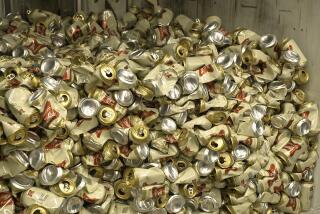Holey Cheese! Swiss Go to Bat for Key Agricultural Export Emmental
- Share via
GENEVA — Switzerland’s most famous cheese, the holey Emmental, is raising a stink.
Swiss makers of the cheese, the country’s biggest agricultural export, are looking to protect its name from competitors around the world that have long copied the pliable nutty-flavored slabs riddled with large round holes created by gases released during fermentation.
Although the effort to limit use of the name Emmental is unlikely to make a difference in North America -- where it has long been loved simply as “Swiss cheese” -- the campaign is causing a meltdown among producers across Europe.
“It will protect the tradition and quality of the Emmental cheese,” said Juerg Jordi of the Federal Agriculture Office of Switzerland, which has announced plans to grant a “Protected Designation of Origin” label to Swiss-made Emmental.
Such a designation could serve as the basis for similar recognition by the European Union and other trading partners.
“It will give Emmental producers a better position with both local and foreign consumers, providing greater assurance and transparency regarding the production method, quality and origin of the cheese,” Jordi said.
His agency rejected 64 objections from within Switzerland and elsewhere in Europe against the proposal to protect the Emmental name. Ten opponents -- mostly from abroad -- have appealed to an independent appeals commission at the Economics Ministry that is expected to rule next year. The case could be further appealed to Switzerland’s supreme court.
International cheese makers argue against the protected designation because more Emmental is produced outside Switzerland than inside, and they say the name is not protected under the benchmark 1951 international Stresa convention, giving all cheese producers the right to use the name.
France is the world’s largest producer of Emmental, making seven times more than Switzerland. Germany, which has been producing the smooth, pale yellow cheese since 1820, is another major producer, as is Denmark.
“The German government and other cheese producers in the EU feel the name Emmental is generic,” said Joerg Rieke, managing director of the German Dairy Assn.
Emmental refers to the valley along the Emme River in central Switzerland, but the government’s definition of the Emmental region generously includes much of the country. Some 245 cheese factories in Switzerland produce Emmental, accounting for 50% of all its cheese exports.
In 2003, the Swiss produced 34,634 metric tons of Emmental and exported nearly 80%. It’s shipped in loaves 30 to 40 inches across and weighing 165 to 265 pounds.
Although it was once thought that good cheese could only be made from the milk of cows raised in the Alps, Emmental was born in the rolling country of the Emme Valley in the canton of Bern.
A cheese from the valley was cited in a 1273 document in the village of Burgdorf, but the term “Emmentaler cheese” was used for the first time in 1542, in a document describing a donation from the bailiff of Aarburg.
Production spread within Switzerland in the 19th century as the market grew abroad for the cheese. Imitators elsewhere caught on quickly, and versions of the cheese were made in many countries.
Ernst Oettli, who employs three people at his small traditional village dairy in northern Switzerland, concedes that Emmental has become a generic name for Swiss cheese, but he says it should be established as a protected name for carefully crafted cheese from the region.
“It will be hard to go back because many years ago, Emmental was declared a generic product, like Camembert or cheddar,” Oettli said. “But if we don’t, we won’t be able to sell our cheese for its real value and, in a few years, all the Emmental in Switzerland will be like that industrialized product.”
Initially, the new labeling requirement would apply only to Swiss producers. But that could change in Europe if the EU agreed to recognize the Swiss designation.
Switzerland and the EU are negotiating mutual recognition of such labels. Currently, only labels awarded to wines and spirits are recognized by both parties.
Under the proposed Swiss designation, Emmental could be made only at local creameries by specialists using traditional recipes. Makers would have to use unpasteurized milk less than 24 hours old, taken from grazing cows not fed from a silo, and cheeses would have to mature for a minimum of four months before sale. Additives and genetically modified ingredients are barred.
The Swiss complain that most Emmental from other countries is mass-produced.
“We are the only ones today who still produce Emmental in a very authentic way, without any artificial flavors or preservatives,” Oettli said.
The difference in production methods gives foreign competitors a price advantage, he said.
More to Read
Sign up for Essential California
The most important California stories and recommendations in your inbox every morning.
You may occasionally receive promotional content from the Los Angeles Times.













